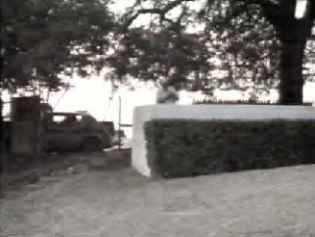

Gordon Arnold demonstrates where he allegedly was standing as the assassination began
Was Gordon Arnold really in Dealey Plaza? Does any evidence confirm his presence there? Did events occur as he described them? Was he consistent in his recollections?
To attempt to answer these questions, let’s walk through the events described by Gordon Arnold more or less chronologically.
It was while walking along the rear of the fence just a few minutes before the assassination that
Arnold claimed to have encountered the agent in plainclothes. In The Men Who Killed Kennedy,
Arnold specified that he encountered the agent just as he was climbing over the steam pipe at the
edge of the lot, momentarily straddling it. Researcher Paul Burke observes that this is the same
pipeline Officer Seymour Weitzman testified he burned his hands on just a few minutes after the
shooting.
![]() Burke has a point; if Weitzman’s testimony is accurate, Arnold should have received
some memorable burns in a most sensitive area of his anatomy.
Burke has a point; if Weitzman’s testimony is accurate, Arnold should have received
some memorable burns in a most sensitive area of his anatomy.
How did the agent identify himself, according to Arnold? In The Men Who Killed Kennedy, the
man is alleged to have stated, “I’m with the CIA.”
![]() But in all previous accounts, the man is
identified as a Secret Service agent.
But in all previous accounts, the man is
identified as a Secret Service agent.
![]() In The Men Who Killed Kennedy, the man is said to have
“pulled out an identification card.”
In The Men Who Killed Kennedy, the man is said to have
“pulled out an identification card.”
![]() But Arnold told Earl Golz and Henry Hurt it had been a
badge.
But Arnold told Earl Golz and Henry Hurt it had been a
badge.
![]()
Why did Arnold obey the agent’s wishes? In the earlier accounts, the agent identifies himself as
a Secret Service agent, someone whose job it would be to protect the President of the United
States. It only “seemed logical to Arnold,” Hurt tells us, that such an individual might want to
restrict access to certain sites overlooking the parade route.
![]() The Golz and Hurt narratives
neither state nor imply that Arnold felt in any way threatened or intimidated by the agent, despite
Arnold’s claim (in 1982) that the man was “wearing a side arm” — a detail present in the Hurt
account but no other.
The Golz and Hurt narratives
neither state nor imply that Arnold felt in any way threatened or intimidated by the agent, despite
Arnold’s claim (in 1982) that the man was “wearing a side arm” — a detail present in the Hurt
account but no other.
![]()
In The Men Who Killed Kennedy, however, it’s not Secret Service “logic” but rather CIA force
that persuades Arnold. Once the man identified himself as a CIA employee, Arnold says, his
reaction was: “Well, that’s enough muscle. I’ll leave.”
![]()
There were, it must be noted, two Dallas police officers assigned to keep outsiders off the
railroad overpass, but no federal agents of any kind.
![]()
In his 1985 interview with Jim Marrs and 1988 interview for The Men Who Killed Kennedy (but
not the 1978 Golz and 1982 Hurt accounts), Arnold described two separate confrontations with
the plainclothes agent, the first right off the railroad bridge, and the second occurring when the
agent followed him through the parking lot and insisted he leave the area behind the stockade
fence completely.
![]()
Interestingly, only a short time before Arnold’s alleged incident, Associated Press photographer
James Altgens had walked through the same parking lot in search of a vantage point from which
to photograph the motorcade. No one approached him or asked him to leave the area.
![]()
Arnold said he then walked around the fence and “stood on a mound of fresh dirt” in order to
film the motorcade.
![]() There was no mound of dirt there, however; rather, there was a park bench,
and there were two people sitting on that bench eating their lunches.
There was no mound of dirt there, however; rather, there was a park bench,
and there were two people sitting on that bench eating their lunches.
![]() By the time Arnold came
forward with his story, the bench was no longer there,
By the time Arnold came
forward with his story, the bench was no longer there,
![]() which may explain its absence from his
account.
which may explain its absence from his
account.
The “mound of fresh dirt” is important, though, because if Arnold had ever stood on the grassy
knoll (whether in 1963 or later), he should have been aware that it would have afforded a terrible
view for filming the motorcade. While Arnold claimed to have been filming prior to the time the
shots were fired, his view of the President would have been largely obscured by road signs, the
many spectators lining Elm Street, and, for a brief time, the concrete wall a short distance in
front of him. Only once JFK had traveled halfway down Elm Street — to the approximate
position of the limousine at the time of the fatal head shot, in fact — would Arnold have had a
clear view of him.
![]()
Abraham Zapruder, the garment manufacturer who would take what is widely considered the
most important film of the assassination, initially intended to film from the knoll, but was unable
to find an unobstructed view of the street there.
![]() The best vantage point Zapruder could find was
a four-foot-high concrete pedestal some twenty feet or so east of Arnold’s alleged position,
The best vantage point Zapruder could find was
a four-foot-high concrete pedestal some twenty feet or so east of Arnold’s alleged position,
![]() and
even this view was completely blocked at one point by one of the larger street signs in the area.
and
even this view was completely blocked at one point by one of the larger street signs in the area.
![]()
Arnold at least partially acknowledged these problems during a 1982 interview with Gary Mack.
According to Mack, Arnold said he had initially planned “to brace himself by the tree but wound
up walking some short distance away as the president neared. He described to me how he
watched the traffic and planned out how he would film JFK. He said the [Stemmons Freeway]
sign would have blocked his view briefly, so he planned to start filming as soon as Kennedy
appeared after the sign.”
![]()
But this makes no sense; the first shot that struck President Kennedy was fired no later than the
instant Kennedy came into Abraham Zapruder’s comparable view, and some believe it was fired
even sooner.
![]() If what he told Gary Mack was true, Arnold would have had no time at all to film
before the shooting began.
If what he told Gary Mack was true, Arnold would have had no time at all to film
before the shooting began.
Arnold initially claimed to have had film of the motorcade confiscated by two police officers,
one of whom was crying and waving a shotgun. It should be borne in mind that, by his own
account, at no point during this alleged confrontation did it occur to him that the police officers
might have had anything to do with the shots that had been fired.
![]() It seems strange, then, that
Arnold, who had shown such willingness to challenge the authority of the alleged agent
“wearing a side arm”
It seems strange, then, that
Arnold, who had shown such willingness to challenge the authority of the alleged agent
“wearing a side arm”
![]() behind the stockade fence (“You and who else is going to keep me off the
bridge?”),
behind the stockade fence (“You and who else is going to keep me off the
bridge?”),
![]() should fail to ask these alleged policemen, “Why are you harassing me? The shots
came from right there behind the fence!” (It is worth pointing out, as well, that Abraham
Zapruder filmed the entire assassination from just a few yards east of Arnold's alleged location,
yet no one tried to seize his film.)
should fail to ask these alleged policemen, “Why are you harassing me? The shots
came from right there behind the fence!” (It is worth pointing out, as well, that Abraham
Zapruder filmed the entire assassination from just a few yards east of Arnold's alleged location,
yet no one tried to seize his film.)
![]()
There is something else that Arnold didn’t think to ask the policemen, or apparently anyone else,
for that matter. Recall that Arnold stated specifically that he “automatically hit the ground”
![]() just
as the shots began. “I buried my head in the ground and heard several other shots,” he said, “but
I couldn’t see anything because I had my face in the dirt.”
just
as the shots began. “I buried my head in the ground and heard several other shots,” he said, “but
I couldn’t see anything because I had my face in the dirt.”
![]()
Following his encounter with the two officers, Arnold told Henry Hurt, he “went straight
home;”
![]() according to Jim Marrs, “Arnold ran straight back to his car and drove out of the
parking lot unchallenged.”
according to Jim Marrs, “Arnold ran straight back to his car and drove out of the
parking lot unchallenged.”
![]() He identified himself to no police officers or other authorities,
He identified himself to no police officers or other authorities,
![]() and
never mentioned having spoken to any bystanders in Dealey Plaza.
and
never mentioned having spoken to any bystanders in Dealey Plaza.
As upsetting as his alleged encounter may have been, it seems striking that, judging from his own account, he did not bother to ask a single person at the scene: “What happened? Has the President been shot?” Wasn’t he even the slightest bit concerned or curious about what had happened?
When did he learn that JFK had been murdered? How did he feel when he heard the news that afternoon that the shots were believed to have been fired by one man, and not from the knoll, but from the Book Depository? How did he feel ten months later when a blue-ribbon presidential commission reached the same conclusion? Was he not the slightest bit inclined to come forward and “set the record straight?” All accounts of his story are silent about these issues.
If Arnold’s story is true, a question arises as to who removed the film from his camera. In The
Men Who Killed Kennedy, Arnold states that he turned his film over to a man wearing a police
uniform, but not, he specifies, the camera itself: “I think I’d have gave him almost anything
except the camera,” he said, “because that was my mother’s.”
![]() (Emphasis added.) Likewise,
Arnold told Earl Golz in 1978 that he himself “took his film from the canister” and threw it to
the policeman.
(Emphasis added.) Likewise,
Arnold told Earl Golz in 1978 that he himself “took his film from the canister” and threw it to
the policeman.
![]()
But in his 1985 account to Jim Marrs, Arnold says that the police officer “told me to give him
my film, so I tossed him my camera. I said you can have everything, just point that gun
somewhere else. He opened it, pulled out the film, and then threw the camera back to me.”
![]() (Emphasis added.)
(Emphasis added.)
Of course, if Arnold truly felt “threatened”
![]() by these policemen (“It wasn’t worth three dollars
and something to be shot. All I wanted them to do was to take that blooming picture [film] and
get out of there, just let me go.”),
by these policemen (“It wasn’t worth three dollars
and something to be shot. All I wanted them to do was to take that blooming picture [film] and
get out of there, just let me go.”),
![]() it’s curious that he would be so worried about his mother’s
camera.
it’s curious that he would be so worried about his mother’s
camera.
This brings us to another striking aspect of Arnold’s account in The Men Who Killed Kennedy. The Golz, Hurt, and Marrs accounts are in complete agreement that Arnold encountered two separate policemen: one who kicked Arnold and demanded that he get up but did not brandish a weapon, and another who was crying and waving around a long gun (specified as a shotgun in the Golz account).
For example, Arnold told Earl Golz in 1978:
“The next thing I knew someone was kicking my butt and telling me to get up.” Arnold said, “it was a policeman. And I told him to go jump in the river. And then this other guy — a policeman — comes up with a shotgun and he was crying and that thing was waving back and forth. I said you can have everything I’ve got. Just point it someplace else.”
Likewise, Arnold specified to Jim Marrs in 1985 that “one of them” (one of the two policemen) demanded his film.
This is not the case in The Men Who Killed Kennedy, however, in which Arnold describes being accosted by a single police officer:
And what happened was that while I was laying on the ground, it seemed like a gentleman came from this particular direction. And I thought it was a police officer . . . But it didn’t really matter much at that time because, with him crying like he was, and with him shaking when he had the weapon in his hand . . . And literally what the man did was kick me, and asked me if I was taking a picture. I told him that I was. And when I looked at the weapon, it was about that big around, and I decided that I would let him have the film. I gave it to him, and then he went back off in this direction . . .
Arnold’s interview in The Men Who Killed Kennedy also adds two new details to his description
of the individual (or, according to his earlier accounts, the second of two individuals) who
accosted him on the knoll. To Earl Golz, Arnold had simply described this man as “a
policeman;”
![]() in Henry Hurt, he was a “second policeman.” But by the time of Arnold’s
appearance in The Men Who Killed Kennedy, he seems to have developed some doubts about the
man’s occupation: “I thought it was a police officer [emphasis added] because he had a uniform
of a police officer, but he didn’t wear a hat, and he had dirty hands.”
in Henry Hurt, he was a “second policeman.” But by the time of Arnold’s
appearance in The Men Who Killed Kennedy, he seems to have developed some doubts about the
man’s occupation: “I thought it was a police officer [emphasis added] because he had a uniform
of a police officer, but he didn’t wear a hat, and he had dirty hands.”
![]()
He didn’t wear a hat, and he had dirty hands.
This description appears in none of Arnold’s earlier accounts, but it’s reminiscent of two items of evidence with which he may have become familiar by the time he was filmed in 1988.
The first item consists of statements by Dallas police officer Joe Marshall Smith, who had
described to the Warren Commission encountering a man on the grassy knoll immediately after
the shooting who displayed the identification of a Secret Service agent. To Earl Golz in 1978,
Smith said, “I remember one thing, he kind of had dirty looking hands or dirty fingernails it
looked like.”
![]() Golz printed this in the same August 27, 1978, Dallas Morning News article that
introduced Gordon Arnold to the world. Note that the man with “dirty looking hands” was not a
man in a police uniform, however, as in Arnold’s story, but a man Smith believed to be a Secret
Service agent.
Golz printed this in the same August 27, 1978, Dallas Morning News article that
introduced Gordon Arnold to the world. Note that the man with “dirty looking hands” was not a
man in a police uniform, however, as in Arnold’s story, but a man Smith believed to be a Secret
Service agent.
![]()
Smit’s description of this alleged agent also bears scant resemblance to Arnold’s Secret Service
(or CIA) agent behind the stockade fence. While Arnold’s agent dressed in a “light-colored
suit”
![]() and was “wearing a side arm,”
and was “wearing a side arm,”
![]() the man described by Smith “looked like an auto
mechanic. He had on a sports shirt and sports pants. But he had dirty fingernails, it looked like,
and hands that looked like an auto mechanic’s hands.”
the man described by Smith “looked like an auto
mechanic. He had on a sports shirt and sports pants. But he had dirty fingernails, it looked like,
and hands that looked like an auto mechanic’s hands.”
![]()
It’s hard to escape the impression that Arnold was simply mixing and matching elements from various stories he had heard or read — and there can be little doubt that Arnold had read Smith’s story in 1978.
The second item of evidence that may have influenced Arnold’s story is an image discovered by
Texas researcher Gary Mack in October 1982, in an “exceptionally clear” second-generation
transparency slide copy of a print of Mary Ann Moorman’s Polaroid photograph of John F.
Kennedy’s assassination that author Josiah Thompson (Six Seconds in Dallas) had obtained in
the 1960s from United Press International.
![]() The image seemed to depict the head and shoulders
of a man behind the stockade fence, in a stance possibly consistent with the firing of a rifle, his
face partly obscured by a white image that could be interpreted as a muzzle flash or smoke from
a rifle.
The image seemed to depict the head and shoulders
of a man behind the stockade fence, in a stance possibly consistent with the firing of a rifle, his
face partly obscured by a white image that could be interpreted as a muzzle flash or smoke from
a rifle.
![]()
Enlarged and enhanced by photo-optics technician Jack White, the image yielded more apparent
details. While this theorized man did not appear to be wearing a hat or cap, what was said to be
his chest and arm seemed to contain images reminiscent of a badge and insignia, not unlike those
worn by a police officer. Mack dubbed the image “Badge Man.”
![]()
After subjecting the enlargements to further scrutiny, Mack and White discovered a less clearly
defined image near “Badge Man” that they thought could be Gordon Arnold.
![]() Shortly thereafter,
Mack reports, he conducted three telephone interviews with Arnold, during one of which, Mack
says, “I told him I had a photograph that may show him [emphasis as in original], but I didn’t
want him to see it until I was certain I had obtained the clearest possible version.”
Shortly thereafter,
Mack reports, he conducted three telephone interviews with Arnold, during one of which, Mack
says, “I told him I had a photograph that may show him [emphasis as in original], but I didn’t
want him to see it until I was certain I had obtained the clearest possible version.”
![]() Arnold’s
filmed interview for The Men Who Killed Kennedy took place in the summer of 1988, Mack
notes, and, according to Mack, “it truly was the first time he [Arnold] had ever seen any version
of the Badge Man blowups.”
Arnold’s
filmed interview for The Men Who Killed Kennedy took place in the summer of 1988, Mack
notes, and, according to Mack, “it truly was the first time he [Arnold] had ever seen any version
of the Badge Man blowups.”
![]()
Is it possible that, contrary to what Gary Mack believes, Arnold had seen or heard about the
“Badge Man” image, published by Mack in 1982,
![]() prior to his filmed interview for The Men
Who Killed Kennedy, and it was this development that inspired the new description of the police
officer as one who was wearing “a uniform of a police officer,” but “didn’t wear a hat”?
prior to his filmed interview for The Men
Who Killed Kennedy, and it was this development that inspired the new description of the police
officer as one who was wearing “a uniform of a police officer,” but “didn’t wear a hat”?
![]() Another element of Arnold’s evolving story suggests this may well have been the case.
Another element of Arnold’s evolving story suggests this may well have been the case.
In addition to the “Badge Man” and alleged Gordon Arnold images in the Moorman
enlargements, Mack and White discovered a third image, which they believed to be a man
wearing a hardhat and white T-shirt standing directly next to the “Badge Man” figure — a
particularly troublesome claim given the fact, acknowledged by both Mack and White,
![]() that
“Badge Man” and friend would have to have been elevated several feet above the ground (for
example, standing on the bumper of a car) in order for their chests to be seen over the five-foot-high fence from Moorman’s vantage point, as Mack and White believed.
that
“Badge Man” and friend would have to have been elevated several feet above the ground (for
example, standing on the bumper of a car) in order for their chests to be seen over the five-foot-high fence from Moorman’s vantage point, as Mack and White believed.
![]()
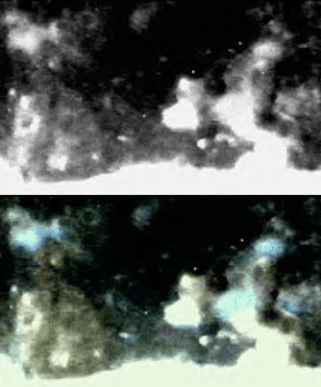
“Badge Man” and friends, as envisioned by Gary Mack and Jack White
When shown a color-tinted version of a Moorman enlargement created by White and Mack,
![]() purportedly for the first time, one of Arnold’s reactions was to ask someone off-camera
(presumably director Nigel Turner), “Would this fella back here [the figure with the hardhat] be
the railroad man I asked you about this morning? Because when I was walking to the site, and I
had never told anybody that I had, when we were out there filming, it reminded me that there
was a railroad worker just standing out there by the railroad tracks.”
purportedly for the first time, one of Arnold’s reactions was to ask someone off-camera
(presumably director Nigel Turner), “Would this fella back here [the figure with the hardhat] be
the railroad man I asked you about this morning? Because when I was walking to the site, and I
had never told anybody that I had, when we were out there filming, it reminded me that there
was a railroad worker just standing out there by the railroad tracks.”
![]()
So in his interviews for The Men Who Killed Kennedy, Arnold has subtracted one of the two
policemen from his earlier accounts, specified for the first time that the man (or one of the men)
wearing a police uniform was bareheaded, and added a railroad worker who plays only a passive
role in his story.
![]()
If these interviews were conducted, as both Nigel Turner and Gary Mack state, before Gordon Arnold became aware of the hypothesized contents of the Mack/White Moorman enlargements, it would indeed be remarkable that his 1988 account suddenly fit so perfectly what Mack and White believed to be shown in Mary Ann Moorman’s photograph.
Can we be as certain as Turner and Mack that Arnold’s recollections were untainted by any knowledge of what Mack and White had discovered, published, and publicized within the Kennedy assassination research community?
Regardless of whether one accepts Gordon Arnold’s story, however, does the Moorman Polaroid corroborate his presence on the grassy knoll that tragic day?
In a word, no.
The simple fact of the matter is that, if the images in the Moorman enlargements were indeed
Gordon Arnold and a man in a police uniform (“Badge Man”), as Mack and White believe, a
distance of about ten feet would have separated the two
![]() — about the same distance that
separated President John F. Kennedy from Dallas police officer Robert W. “Bobby” Hargis at
the exact same instant, as depicted in the Zapruder film.
— about the same distance that
separated President John F. Kennedy from Dallas police officer Robert W. “Bobby” Hargis at
the exact same instant, as depicted in the Zapruder film.
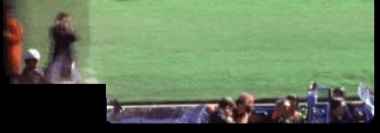
At left: eyewitness Jean Hill in red, Officer Bobby Hargis, Mary Moorman about to snap her picture
Officer Hargis is also prominent in Mary Moorman’s Polaroid: look at the obvious disparity between the relative size of the President’s head compared to that of Hargis, and that of the alleged figure of Gordon Arnold compared to that of Mack and White’s “Badge Man,” though each pair of figures would be located approximately the same distance apart.
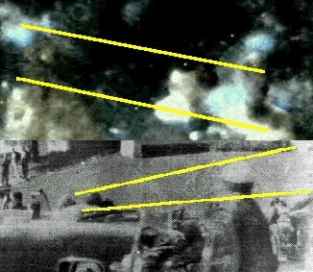
Simply put, while either Mack and White’s “Badge Man” or “Gordon Arnold” figure could conceivably depict an actual human being on the knoll, it is impossible for both to be people. Of course, if either one of these images is nothing more than an illusion, it raises serious questions about the validity of both.
As researcher Greg Jaynes points out, the features of the “Badge Man” image are remarkably
well defined, while the edge of the white concrete wall, located some thirty-seven feet closer to
the camera than the theorized position of “Badge Man,” is captured in Moorman only as a sea of
gauze and fuzz;
![]() the same criticism applies to the “Gordon Arnold” and “Hardhat Man” figures.
Of course, it is a photographic impossibility for objects further from the plane of focus of the
photograph to be in sharper focus than objects nearer to it; this strongly suggests that the three
images are illusions resulting from photographic artifacts, light glimpsed through the trees in the
background, distortions resulting from an object located in between Moorman’s camera and the
picket fence, or a combination of some or all of these factors — just like other “assassins” found
in Mary Moorman’s grainy Polaroid and eventually debunked by analysts, including Gary Mack
himself.
the same criticism applies to the “Gordon Arnold” and “Hardhat Man” figures.
Of course, it is a photographic impossibility for objects further from the plane of focus of the
photograph to be in sharper focus than objects nearer to it; this strongly suggests that the three
images are illusions resulting from photographic artifacts, light glimpsed through the trees in the
background, distortions resulting from an object located in between Moorman’s camera and the
picket fence, or a combination of some or all of these factors — just like other “assassins” found
in Mary Moorman’s grainy Polaroid and eventually debunked by analysts, including Gary Mack
himself.
![]()
Furthermore, Gordon Arnold stated consistently that he dropped to the ground just after the first
shot was fired; but the first shot was fired no later than the time frame 224 of the home movie
taken by Dallas garment manufacturer Abraham Zapruder was exposed,
![]() and very possibly as
early as Zapruder frame 155.
and very possibly as
early as Zapruder frame 155.
![]() If Arnold’s account is accurate, how can he still be standing at the
time of the head shot (captured in Zapruder frame 313, about the same time the Moorman
Polaroid was taken)?
If Arnold’s account is accurate, how can he still be standing at the
time of the head shot (captured in Zapruder frame 313, about the same time the Moorman
Polaroid was taken)?
Finally, if Gordon Arnold’s story is true and the Mack/White “Badge Man” theory is also true, where was “Badge Man” just a few minutes earlier, when Arnold was allegedly behind the fence?
Arnold consistently stated that he had been “walking behind [the] fence on top of the grassy
knoll minutes before the assassination” toward the railroad bridge.
![]() After his purported
encounter (or encounters) with the federal agent, Arnold “walked the complete length of the
fence,”
After his purported
encounter (or encounters) with the federal agent, Arnold “walked the complete length of the
fence,”
![]() this time in the other direction, before he got around on the other side. We know that
the President’s motorcade was running some five minutes behind schedule.
this time in the other direction, before he got around on the other side. We know that
the President’s motorcade was running some five minutes behind schedule.
![]() If a man in a police
uniform was supposed to kill the President from behind the fence on the grassy knoll, where was
he?
If a man in a police
uniform was supposed to kill the President from behind the fence on the grassy knoll, where was
he?
As far as photographic corroboration for Arnold’s story goes, the only issue that remains is whether or not he could be the figure known as “Black Dog Man.”
“Black Dog Man” is the name given to a bystander glimpsed hidden in shadow behind the
concrete wall in photographs taken by spectators Phil Willis and Hugh Betzner; the description
comes from the silhouette’s slight resemblance to a black dog crouched upon the wall. As this
person has never identified him- or herself, and his or her features are far too indistinct in these
photographs to allow for any possible identification, his or her identity remains open to
speculation.
![]()
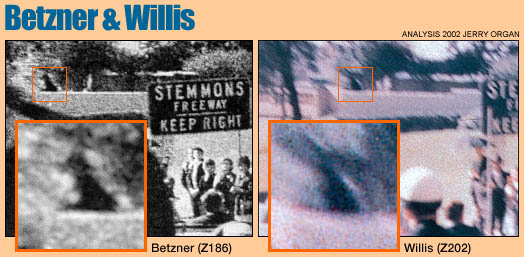
“Black Dog Man” cannot be Gordon Arnold, however, as he or she appears to be standing against the wall (see below), while Arnold claimed to have been standing a short distance across the sidewalk from the wall; and “Black Dog Man” certainly does not appear to be filming the motorcade.
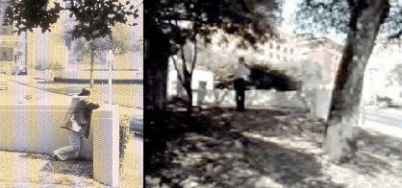
Left: researcher J. Gary Shaw demonstrates “Black Dog Man’s” position for Robert Groden.
Right: Gordon Arnold stands where he claimed to have been positioned during the assassination.
Despite the dearth of evidence, there is one eyewitness who has been alleged to confirm Gordon Arnold’s presence in Dealey Plaza.
Faces in Odd Places If one looks at enough photographs, faces can turn up in all kinds of strange places. Consider, for example, this photo of the World Trade Center towers in the wake of the 9/11 terrorist attacks. Some see the face of Satan, perhaps gloating over the evil he has caused. Then there is this famous photo of the "face on Mars," photographed by NASA's Viking Orbiter in 1976. How did it get there? Does it show intelligent life, perhaps trying to communicate with other races from other planets? As it happens a probe in 2001 obtained a much higher resolution photo of the same area, and the "face" is shown to be a rather ordinary geological structure. It's not possible, unfortunately, to go back to Dealey Plaza and rephotograph "Badgeman." If he was ever there, he's now long gone. |
As noted previously, Arnold’s story was first publicized in a Dallas Morning News story of
August 27, 1978. A follow-up story of Sunday, December 31, 1978, again authored by Earl
Golz, noted, “Some assassination researchers said they doubted Arnold’s story because they
could not find him in photographs and movie film taken at the time of the assassination.”
![]()
However, Golz wrote, Arnold’s “presence on the grassy knoll was confirmed Saturday by former
U.S. Sen. Ralph Yarborough of Texas, who was riding in the motorcade two cars behind the
presidential limousine. He was a passenger in a car with Vice President Lyndon Johnson and
Mrs. Johnson.”
![]()
“Immediately on the firing of the first shot I saw the man you interviewed throw himself
on the ground,” Yarborough told The News. “He was down within a second of the time
the shot was fired and I thought to myself, ‘There’s a combat veteran who knows how to
act when weapons start firing.’”
![]()
Yarborough elaborated slightly upon his statement ten years later, in The Men Who Killed Kennedy:
During that shooting my eye was attracted to the right. I saw a movement and I saw a man just jump about ten feet like at the old time flying tackle in football and land against a wall. I thought to myself, “There’s an infantryman who’s either been shot at in combat or he’s been trained thoroughly: the minute you hear firing, get under cover.”
Yarborough saw someone “jump about ten feet like at the old time flying tackle in football and
land against a wall;” Gordon Arnold said he “hit the dirt”
![]() behind the concrete wall.
behind the concrete wall.
Gordon Arnold said he was in uniform that day;
![]() Yarborough surmised that the bystander he
saw was an infantryman or combat veteran, because he appeared to know “how to act when
weapons start firing.”
Yarborough surmised that the bystander he
saw was an infantryman or combat veteran, because he appeared to know “how to act when
weapons start firing.”
Was Yarborough describing Gordon Arnold, or someone else entirely?
In 1993 Ralph W. Yarborough was interviewed at his Austin home by historian David Murph of Texas Christian University. Murph reminded Yarborough that he had been quoted as saying he had witnessed a man on the grassy knoll throw himself down on the ground, and that the man had impressed him as a combat veteran.
Yarborough seemed puzzled to hear that his words had been applied to someone standing on the
grassy knoll. That couldn’t possibly be correct, he insisted repeatedly. “Remember where I was
in the motorcade — with the Johnsons,” he cautioned Murph, “too far back to have been able to
see anyone [on the knoll] drop to the ground when firing began.”
![]()
Whoever Yarborough had described (and there were many people in Dealey Plaza throwing
themselves down on the ground as the shots rang out),
![]() it could not have been Gordon Arnold.
it could not have been Gordon Arnold.
What really happened on the knoll during the assassination? Does any evidence corroborate Gordon Arnold’s claims about what occurred during and after the shooting?
| Continue to Part Three |